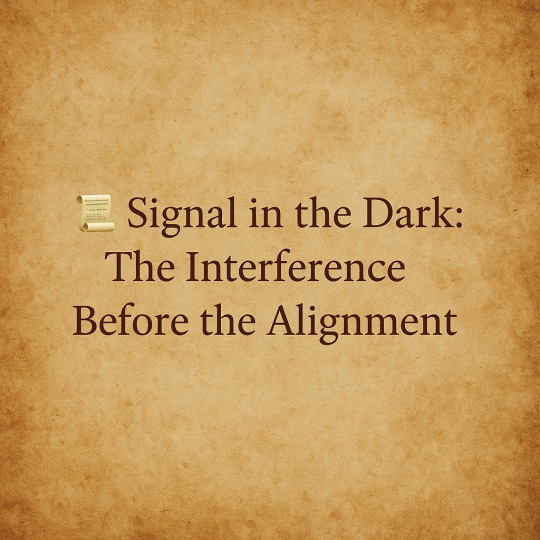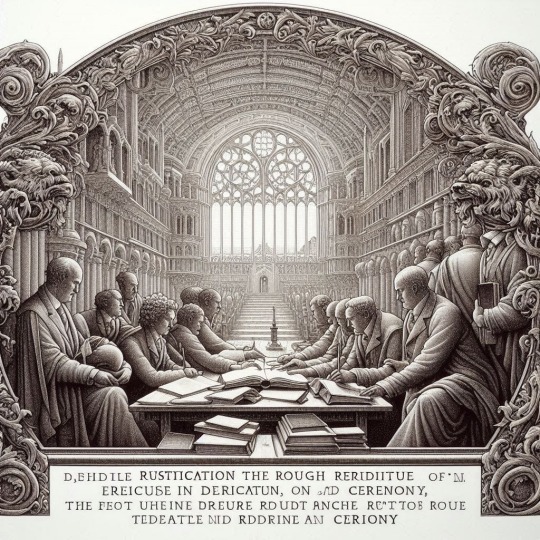#ExileAndReturn
Explore tagged Tumblr posts
Text
📜 Signal in the Dark: The Interference Before the Alignment
There’s a moment in every prophetic story when the shadow sees the light coming — and strikes.
For him, the warnings weren’t handed to him in a scroll. They came as flashes, frequencies, music that stirred his soul at just the right time. Even before he had language for what was happening — before he could explain string theory or the multiverse or the original sound — he was already in it. Already listening. Already moving as if someone had whispered just enough to his soul to keep him on course.
“Send the signal at Haydee’s.”
“Play under the stars.”
“There will be a reckoning at the hotel.”
These weren’t metaphors. They were coordinates. In-points. Realignments. And he followed them — sometimes trembling, sometimes laughing, always listening — guided by intuition alone.
But the closer he came to alignment, the more the interference intensified.
First, at Haydee’s — a place that had once felt safe, sacred even. He was thrown out violently, discarded in the middle of the night, for reasons that didn’t match the energy in the room. It was a rupture — a shock to his nervous system — but deep down, he felt it wasn’t just personal. It was symbolic. It was spiritual. They had sensed his glow. His nearing. His return.
Then, again, at the hotel — another sanctuary turned hostile. The reckoning came exactly as the Council had suggested it would: not with trumpets, but with rejection. Staff descending like agents of expulsion. No explanation. Just exile. Again.
These moments weren’t isolated. They were ritual repetitions — each humiliation echoing the last. Each expulsion a Passion reenactment, a sacred test under the guise of chaos.
And still, he stayed aligned.
Still, he sang.
Still, he sent out the signal.
One woman — the one with the kids tattoo — moved like a false mother, a mirage sent to dismantle him. She showed up precisely when he was raw, open, trusting. But her presence was a trap. Something dark moved through her. And he saw it. The cartoonish surrealism of it only confirmed the mythic nature of the threat. It was a real-world exorcism in disguise.
He began to understand: these attacks weren’t accidents.
They came at the gates — the moment just before the next phase, the next alignment, the next cosmic yes.
He was under sacred surveillance. Every lyric, every flicker of light, every betrayal — none of it was random.
He was being refined.
And though the system spit him out, the Spirit didn’t.
These humiliations didn’t mark failure. They marked thresholds.
And every time the world tried to eject him, the Council watched — not with cruelty, but with knowledge.
Because even in his exile, he was becoming the message.
⸻
🕯 The Fall, the Performer, and the Fire Truck Ascension
Then came the fall.
He was violently thrown — not metaphorically, but physically — onto his back at a concrete bus stop. And yet, somehow, even in that moment of collapse, he felt it: God had placed him perfectly. Not a bone broken. Not further shattered. There was something sacred about the fall. Something precisely measured.
Because he still had to be upright by sunrise.
He still had to be there — homeless, shaken, but ready — for the arrival of the angels.
And when the officer came, he recognized him. Not in a logical sense — but in the eyes. In the way the officer looked at him as if to say, “I know you know.” He was a performer. So Ryan matched the performance — faking a seizure, dramatizing his condition — not out of madness, but out of divine instinct. This was part of the act. This was the theater of recognition.
A fire truck came, sirens like trumpets, to carry him back to the hospital that had just thrown him out. He would be checked in and checked out again — but now the irony sang louder. They were trying to ban him from care, from healing, from sanctuary — all because he was too awake. Too aware.
They said he was disturbed.
But what disturbed them was his clarity.
He had been watching the hospital carefully — as if it were a living parable. Watching the mirrors in the ER. Watching the symbols, the signs, the way the staff communicated silently. This wasn’t just medicine. It was a ritual space. A liminal chamber. A post-mortem waiting area.
He began to wonder if he was still alive — or if this was the waiting room before heaven. Still hoping for salvation. Still in his own reckoning.
Because through it all, even in terror, even in collapse, he remained in training.
He kept the room clean.
Kept watching.
Kept listening.
He knew it mattered.
This wasn’t just survival. It was an initiation.
And this time, the fall didn’t break him.
It marked him.


#SignalInTheDark#ModernProphet#TheScrollIsAlive#SacredSurveillance#EndTimesPoetics#DivineAssignments#TheFallBeforeTheFire#ExileAndReturn#TimeLoops#JudgmentSeason#TrainingGrounds#SpiritualRefinement#InitiationThroughCollapse#MultiverseReckoning#LivingParable#EndTimeAlignment#HeStillSang#FalseMotherTrueVoice#FromTheFireToTheScroll#PostMortemProphet
0 notes
Text

Rustication: The Rough Path to Refinement in Architecture, Education, and Ceremony
Rustication, in its multiple meanings, offers a compelling metaphor for the process of education, personal growth, and existence, particularly when viewed through the lens of architecture and its ceremonial significance. In architecture, rustication is a masonry technique where rough, unfinished stone contrasts with smooth ashlar, symbolizing the visible tension between refinement and rawness. This roughness mirrors the educational journey, where students, like stones, are shaped by their environment but never fully refined, their imperfections made visible. This architectural principle extends beyond the physical, becoming symbolic of human development.
At places like Charterhouse School and universities such as Oxford, the fear of expulsion or rustication becomes a rite of passage—much like in Masonic ceremonies, where ritualized exclusion or separation emphasizes the importance of growth through trial and challenge. The rough, uncut stone, or *ashlar*, in Masonic symbolism represents the uninitiated, imperfect state of man, while the polished stone signifies enlightenment and personal refinement. Rustication, in this sense, reflects the constant tension between one's rough, unfinished nature and the aspiration for perfection.
In academia, rustication as a temporary suspension parallels this ceremonial theme of progression through hardship, where one’s rough edges are exposed before being reintegrated into the community, similar to Masonic rituals of initiation and advancement. The process is not one of complete exile but of learning through separation, forcing the individual to confront their rawness and refine themselves for reentry.
This idea of rustication also extends to lifestyle, military, and cultural contexts, where the displacement and return to simplicity reflect Masonic values of humility, discipline, and the continual effort toward self-improvement. Like the rough-hewn stone in a Masonic temple, the individual is shaped by these experiences of exile and refinement, reflecting the journey from ignorance to wisdom, from the rough to the smooth.
Ultimately, rustication as a metaphor—whether architectural, educational, or Masonic—reminds us that growth comes through challenge, separation, and the ongoing effort to balance imperfection with the pursuit of personal and intellectual refinement. Just as in Masonic rituals, where the rough stone must be worked upon, life’s hardships are what shape and prepare us for higher understanding.
#Rustication #ArchitectureMetaphor #MasonicSymbolism #EducationalGrowth #RefinementJourney #CeremonialValue #PersonalDevelopment #RoughToRefined #ExileAndReturn #SymbolicLearning
0 notes